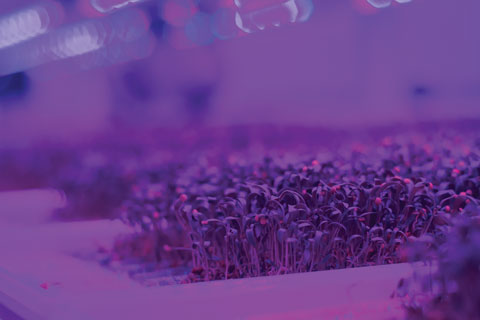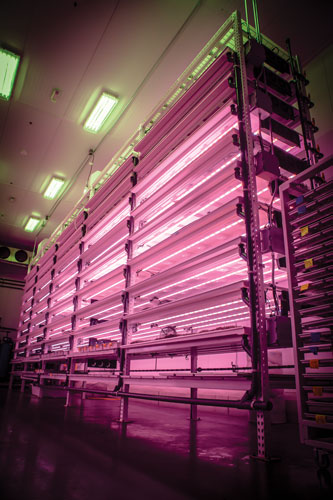11/1/2023
Vertical Farm Site Selection
David Kuack
 A major consideration when starting an indoor farm is site selection, which can have a direct bearing on efficiency and profitability.
A major consideration when starting an indoor farm is site selection, which can have a direct bearing on efficiency and profitability.
There are lots of factors to take into consideration, from the physical location to the utilities available, nearby neighbors and more. Here we break down what to think about before your next retrofit or build.
Pictured: Nadia Sabeh, founder and president of Dr. Greenhouse Inc., said some successful indoor vertical farms have been small-scale operations that produce niche crops, such as microgreens and herbs. Photo courtesy of Farmbox Greens.
Know your market
“Choosing a site starts with your market,” said Tyler Baras, cofounder and chief science officer at Area 2 Farms, an indoor farm operation in Arlington, Virginia. (Tyler also was on the cover of Inside Grower in October 2016.) “If you want to build a farm to supply retail, then an indoor farm might not even be the right production facility for that market. It might make more sense to find an inexpensive piece of land and construct a greenhouse to grow more crops.
“The cost per square foot for building a greenhouse is cheaper than for an indoor farm. What sometimes is forgotten with greenhouses is the minimum scale required. For most leafy greens grown using a semi-automated production system, it’s going to take a minimum of an acre. Even if the cost per square foot is relatively low, the minimum size is an acre, which is still a major cost.”
Market research can be critical to the success of an indoor farm.
“Unfortunately, some indoor farms are failing because they didn’t do enough market research to really understand whether consumers want or need more lettuce or produce,” Nadia Sabeh, founder and president of Dr. Greenhouse Inc., in Sacramento, California. “Consumers already used to paying a certain price for lettuce may not be willing to buy lettuce from an indoor farm that is two to four times the cost of what they typically pay regardless if it is fresher or grown more sustainably. Before choosing a site, growers need to understand who the consumer is and what they are willing to pay for the crops that will be produced.”
Urban versus rural location
Being able to move harvested crops makes proximity to transportation highways critical, whether you’re considering urban or rural.
“Being near a major roadway, railway or airport, depending on how the crops are going to be shipped, is important—not only for delivering the product, but also in terms of maintaining freshness,” Nadia said. “This not only applies to delivering products to consumers, but also how supplies are brought into the farm.
“If a production facility is located in a rural area, even though land may be cheaper, transportation costs are going to be higher, and the purchasing and selling of goods may be more expensive.”
 Moving product out and supplies in to an indoor farm in a city may be just as difficult as in a rural setting, though.
Moving product out and supplies in to an indoor farm in a city may be just as difficult as in a rural setting, though.
“In an urban environment, there is going to be more traffic, both vehicles and people,” she added. “Locating in a city may require obtaining a variance in terms of the zoning that applies to an indoor farm. Is it considered commercial, industrial or agricultural? This could be a barrier if a grower tries to build an urban farm in the middle of a city.”
Pictured: An indoor farm grower planning to stay in a building for 10 to 20 years will realize the cost savings of installing energy-efficient equipment and benefits from upgrading the facility. Photo courtesy of Farmbox Greens.
Finding a suitable, affordable site
Tyler said one of the biggest obstacles he encountered in locating a site for his indoor farm is the time it took to find a suitable building and to acquire the lease. It took over a year to find a building and to complete the leasing agreement.
“Many property owners are primarily interested in renting to well-established companies, including chains,” he said. “That is their first priority. They aren’t willing to take a chance on a start-up company. The terms of a rental agreement and the amount of the security deposit can be deal-breakers. Sometimes the security deposit was outrageous; it would have tied up all the capital we had available. The permitting process can also be cumbersome.”
He added it’s difficult to find a rental property with a lease for less than 10 years for a commercial operation. And a grower owner/operator who’s leasing or renting a building may be constrained in terms of the upgrades that can be made.
“The property owner may not want changes made to the building,” Nadia said. “If a grower decides to leave after the agreement runs out, the rental value or property value may be less because of all the assets that don’t really apply to other potential occupants.
“On the flip side, a grower owner/operator might not want to invest in upgrading a property they don’t own. There is not a lot of incentive to install energy-efficient equipment or make upgrades to a building because the grower is not reaping the benefits of increasing the property value. But that is being short-sighted. If a grower plans to stay in a building for 10 to 20 years, then the cost savings for installing energy-efficient equipment or for upgrading the building is going to pay back to the grower’s bottom line regardless of whether they helped the property owner.”
The building matters
The skin or envelope of the building can be just as important as the building’s indoor space, Nadia said, including the insulation. She advocates for good insulation, both to have a high R value to prevent heat transfer in and out, and also to have a vapor barrier.
“A vapor barrier prevents water vapor from migrating into the building if it is humid outside or out of the building if it is more humid inside. This is important not only for the control of the indoor growing environment, but also to prevent degradation of materials in the building due to mold or bacteria that can grow on insulation and wood,” she said. “If water is allowed to migrate into the building, this can lead to rotting and/or corroding of materials. A vapor barrier can prevent this from happening.”
The type of floors in a building can be a critical factor in the smooth operation and installation of production system equipment. Growers looking to start an indoor farm should look for a facility with floor drains due to the amount of water and sanitation that will be needed.
One of the factors Nadia always considers when looking at a potential indoor farm site is where is the HVAC equipment going to be installed.
“Most growers realize that cooling and dehumidification equipment is needed for these indoor production facilities,” she said. “The question becomes is the equipment going to be located on the roof of the building, next to the building or in the building itself? What are the weight and the space requirements of the equipment?
“The roof may not be able to handle the weight load [and] the property line may be too short to handle the size of the HVAC equipment, which leaves installing it inside the building,” she added. “Placing the equipment in the building could potentially reduce the cultivation area. If a grower chooses to install smaller HVAC units inside the grow rooms, this is also going to reduce the space that could be used to grow plants.”
Access to utilities
Utilities should be one of the first things looked at when evaluating different properties and comparing them. Access to electricity, natural gas, water and sewage removal, and the capacity of these utilities to a site can be critical.
Nadia noted upgrading electrical can be slow and expensive. “Transformers are one of the biggest limitations in project lead times or development times that are occurring right now,” she said. “Delivering switch gears and transformers for upgrading the electrical power to a site can take anywhere from 40 to 80 weeks just to upgrade the power.”
Know whether the building is heated with natural gas or electricity (right now the cost of natural gas is lower), and understand the site’s power availability.
“Understanding a site’s power availability is key to all the decisions that will be made down the line, as well as the time it is going to take to build out a project,” she said.
Also, know how much water is available and the requirements for water and sewage removal. If using a municipal water source, there are likely to be requirements to filter and treat the water before it’s sent to the sewer.
The water quality values from a municipal source are going to be different than those in rural locations where water is pulled from a well or nearby river or stream. Have the water tested at different times of the year to adjust for seasonal changes.
Would you be my neighbor?
An important consideration when choosing between a rural and urban site is who are going to be your neighbors.
“In a rural location, an indoor farm might be surrounded by field farms,” Nadia said. “These operations are probably applying pesticides and fertilizers, which can drift into a facility and be a detriment to the plants and may impact the goal of trying to grow without chemicals. There can also be a problem with rodents and/or pests that migrate from nearby fields and find their way into an indoor farm next door.”
Indoor farms located in an urban or industrial environment may have to contend with exhaust fumes from cars, trucks and industrial operations.
“Air pollutants can enter an indoor farm facility without proper filtering or infrequent changes of the air filters,” she said. “If the farm is located in a dense urban environment with a lot of traffic, there is going to be carbon monoxide and NOx in the air. These air pollutant constituents can be bad for both human and plant health.”
David Kuack is a freelance technical writer in Fort Worth, Texas. Email him at dkuack@gmail.com.